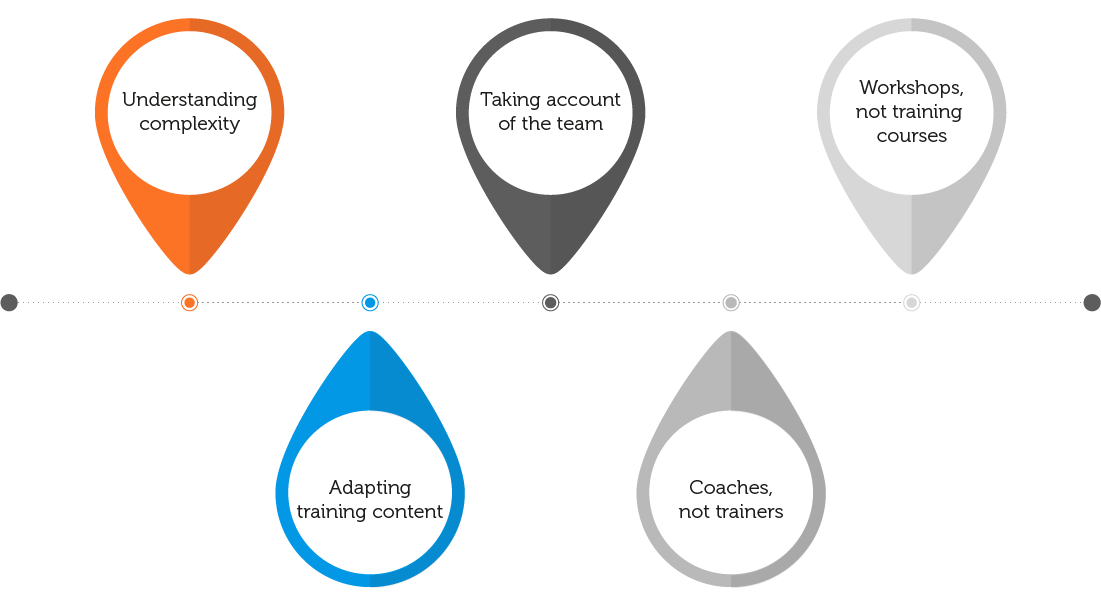The “virtual man” in a jungle of digital complexity
Show me similar content
Agility
The “virtual man” represents the men and women of modern society, a “natural habitat” shaped first and foremost by advanced information and communication technologies. Ever-expanding digitalization, artificial intelligence and the Internet of Things are intensifying the connection between systems and machines. The boundaries have become fluid and only become apparent upon closer inspection. Although machines communicate and interact in the background, unnoticed by virtual man, he does benefit from them.
Routines make machine learning possible, which in turn leads to process optimization. Computers help make decisions, while assistance systems schedule appointments over the phone, give directions and read out text messages – in flawless English and in a voice barely distinguishable from that of a human. There’s a vast abundance of knowledge at our fingertips and we can access it pretty much wherever and whenever we want.
The concept of man in a modern world
As appealing as this new world may seem, it doesn’t come with instructions or a support hotline. And in the center of it all is the virtual man – representative of the men and women of today – , trying to find his way and searching for clarity, structure and security. He stands for a person who is experiencing the world as if it has just been created because his environment is constantly changing. This results in:
- Losing traditions as codes of conduct (detraditionalization)
- Not being able to make comparisons because situations are completely new (individualization)
- Needing to continuously make decisions to pick from an overabundance of options (choice of options)
The virtual man braves an unrelenting flow of change, showing himself to be flexible and adaptable. He forms networks to discuss ideas with others and to develop his own routines.
Nevertheless, he is exposed to a great deal of stress. He is faced with volatility, uncertainty, complexity and ambiguity. Welcome to the VUCA world! So what does our man need so he can harness the benefits of his era? How can his day-to-day activities be made less taxing?
State-of-the-art learning shows the way
Demand- and needs-based learning is the compass with which the virtual man can find his way through a jungle of possibilities.
Understanding complexity
New technologies factor in user-friendliness, making it relatively straightforward to get to grips with how they work. The real challenge, first and foremost in the context of day-to-day work, is understanding how the individual elements are networked together. How do they interact? If you change a unit, how will that impact on the associated structure?
Adapting training content
The virtual man needs a guide to point out correlations and lead the way. Transposed to a professional context, this means the advent of new technologies has also shifted the focus in the world of training. In the past, the overriding aim was to teach application expertise. Now, it’s also about developing a global understanding of interdependencies.
Taking account of the team
Besides the individual level, the team perspective is also becoming more important in the training process. What approaches are suitable? Which processes could prove useful? Establishing new guidelines as a team makes it easier to tackle a high level of complexity and helps alleviate feelings of uncertainty among the workforce.
Coaches, not trainers
Demand for “conventional” trainers is dwindling, with a growing need for consultants and coaches who can be flexible in how they address the specific requirements and needs of organizations and employees. Besides having application expertise, these coaches and consultants now need to think much more in terms of processes and structures, and build a bridge to the aspirations of their target group.
Workshops, not training courses
Against this backdrop, training programs are moving away from traditional styles of instruction toward group events with a workshop feel to them. In this scenario, the coach takes on the task of hosting and structuring the event. But it is the team – under the coach’s expert supervision – that independently devises the solution for the situation at hand.
The evolution of the concept of man has inevitably triggered a revolution in the training landscape. What is needed is not one-size-fits-all solutions, but rather bespoke approaches geared toward an agile, independent community. With the right partner at his side – a consultant or coach who has understood exactly that and taken it to heart – the virtual man will not lose his bearings, even in the vast universe of digital diversity. He will thus be perfectly equipped to master the changes brought about by digitalization.
Show me similar content
Agility



